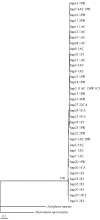Significant genetic differentiation among populations of Anomalocardia brasiliana (Gmelin, 1791): A bivalve with planktonic larval dispersion
- PMID: 21637701
- PMCID: PMC3036935
- DOI: 10.1590/S1415-47572009000200033
Significant genetic differentiation among populations of Anomalocardia brasiliana (Gmelin, 1791): A bivalve with planktonic larval dispersion
Abstract
Four Brazilian populations of Anomalocardia brasiliana were tested for mutual genetic homogeneity, using data from 123 sequences of the mtDNA cytochrome oxidase c subunit I gene. A total of 36 haplotypes were identified, those shared being H3 (Canela Island, Prainha and Acupe) and both H5 and H9 (Prainha and Acupe). Haplotype diversity values were high, except for the Camurupim population, whereas nucleotide values were low in all the populations, except for that of Acupe. Only the Prainha population showed a deviation from neutrality and the SSD test did not reject the demographic expansion hypothesis. Fst values showed that the Prainha and Acupe populations represent a single stock, whereas in both the Canela Island and Camurupim stocks, population structures are different and independent. The observed structure at Canela Island may be due to the geographic distance between this population and the remainder. The Camurupim population does not share any haplotype with the remaining populations in northeastern Brazil. The apparent isolation could be due to the rocky barrier located facing the mouth of the Mamanguape River. The results highlight the importance of wide-scale studies to identify and conserve local genetic diversity, especially where migration is restricted.
Keywords: mtDNA; Anomalocardia brasiliana; COI; conservation; population.
Figures



Similar articles
-
Population structure of the bivalve Anomalocardia brasiliana, (Gmelin, 1791) in the semi-arid estuarine region of northeastern Brazil.Braz J Biol. 2013 Nov;73(4):819-33. doi: 10.1590/s1519-69842013000400019. Braz J Biol. 2013. PMID: 24789399
-
Presence of enteric viruses, bioaccumulation and stability in Anomalocardia brasiliana clams (Gmelin, 1791).Int J Food Microbiol. 2018 Feb 2;266:363-371. doi: 10.1016/j.ijfoodmicro.2017.08.004. Epub 2017 Aug 12. Int J Food Microbiol. 2018. PMID: 29074195
-
Fasciola hepatica in Brazil: genetic diversity provides insights into its origin and geographic dispersion.J Helminthol. 2019 Sep 9;94:e83. doi: 10.1017/S0022149X19000774. J Helminthol. 2019. PMID: 31495340
-
Population genetic diversity of sesarmid crab (Perisesarma bidens) in China based on mitochondrial DNA.Mitochondrial DNA A DNA Mapp Seq Anal. 2016 Sep;27(5):3255-62. doi: 10.3109/19401736.2015.1015002. Epub 2015 Feb 19. Mitochondrial DNA A DNA Mapp Seq Anal. 2016. PMID: 25693695
-
High genetic diversity in the offshore island populations of the tephritid fruit fly Bactrocera dorsalis.BMC Ecol. 2016 Oct 13;16(1):46. doi: 10.1186/s12898-016-0101-0. BMC Ecol. 2016. PMID: 27737670 Free PMC article.
Cited by
-
Mitochondrial and nuclear genetic analyses of the tropical black-lip rock oyster (Saccostrea echinata) reveals population subdivision and informs sustainable aquaculture development.BMC Genomics. 2019 Sep 12;20(1):711. doi: 10.1186/s12864-019-6052-z. BMC Genomics. 2019. PMID: 31514727 Free PMC article.
-
On the comparison of population-level estimates of haplotype and nucleotide diversity: a case study using the gene cox1 in animals.Heredity (Edinb). 2012 Jul;109(1):50-6. doi: 10.1038/hdy.2012.12. Epub 2012 Mar 21. Heredity (Edinb). 2012. PMID: 22434013 Free PMC article.
References
-
- Abbott R.T., Morris P.A. A Field Guide to Shells. Atlantic and Gulf Coasts and the West Indies. 4th edition. New York: Houghton Mifflin Company; 1995.
-
- Alves R.R.N., Nishida A.K. A ecdise do caranguejo-uça, Ucides cordatus L. (Decapoda, Brachyura) na visão dos caranguejeiros. Interciencia. 2002;27:110–117.
-
- Arruda E.P., Amaral A.C.Z. Spatial distribution of mollusks in the intertidal zone of sheltered beaches in southeastern of Brazil. Rev Bras Zool. 2003;20:291–300.
-
- Bandelt H.J., Forster P., Rohl A. Median-joining networks for inferring intraspecific phylogenies. Mol Biol Evol. 1999;16:37–48. - PubMed
-
- Barreira C.A.R., Araujo M.L.R. Ciclo reprodutivo de Anomalocardia brasiliana (Gmelin,1791) (Mollusca, Bivalvia, Veneridae) na praia do Canto da Barra, Fortim, Ceará, Brasil. Bol Inst Pesca. 2005;2005;31:9–20. (Abstract in English)
LinkOut - more resources
Full Text Sources
Miscellaneous
